After our preview about the Republic P-47, it’s time to present the second aircraft coming in the new wave of WW2 Wings of Glory Airplane Packs: the final production version of the German the Messerschmitt Bf.109 K single-seat fighter. Considered one of the first truly modern fighters of WW2, it was also called the Me 109.
The Bf.109 was designed in the mid-1930s by Willy Messerschmitt and Robert Lusser for the Bayerische Flugzeugwerke company, to meet the Luftwaffe requirements for a low-wing all-metal monoplane with retractable undercarriage, for the role of a high-speed, short range interceptor. The Messerschmitt design proved to be very advanced, with a fully enclosed cockpit and the narrowest fuselage possible that could take either of the two most powerful aircraft engines then under development in Germany – the Junkers Jumo 210 and the Daimler Benz DB 600. The first prototype was ready in mid-1935, flying for the first time in September 1935.
The first Bf.109s saw operational service in 1937, during the Spanish Civil War. The fighter was still in service (and development) at the end of World War II, with several variants and versions introduced along the years. Although the initial design was for an interceptor, later models were developed to fulfill multiple roles – as bomber escort, fighter-bomber, ground-attack aircraft, and reconnaissance aircraft. A total of 33,984 Bf.109 units were built from 1937 to 1945, or 57% of all German fighter types produced.
The Bf 109 E had become the main fighter of the Luftwaffe, replacing the biplane fighters, by September 1939. The only single engine German fighter in use during the Battle of Britain, it proved to be the equal of the Spitfire, and superior to the Hurricane. But the 109 had a limited range and could not spend too much time over the target, so their fighting time was limited as a escort fighter, a role for which it was not originally designed. In the spring 1941, it started to be replaced by the 109 F. The Bf.109 G, introduced in 1942, was the most numerous version, with around 10,000 units created in ten main variants, and used by every German day fighter unit, and by eight other countries.
The Bf.109 K, code name "Kürfurst," started development in the spring of 1943, in an attempt to incorporate the best features from the many versions of the 109G and produce a standard aircraft with a streamlined production process. The prototype was ready by autumn of that year, and production started in August 1944. The K-4 was the only version to be mass-produced. Deliveries began in October 1944, and by the end of January 1945 314 K-4s were listed on hand with first line Luftwaffe units.
The K series was powered by the Daimler-Benz DB 605DB/DC engine, which had an adjusting screw allowing the engine to use either B4 + MW 50 Methanol Water injection equipment or C3 fuel (DB 605 DB) or C3 fuel, with or without MW 50 (DB 605 DC). With the MW 50 and maximum boost, the Bf.109 K-4 was the fastest 109 of World War II, reaching a maximum speed of 710 km/h (440 mph) at 7,500 m (24,610 ft) altitude. Without MW 50 and using 1.80 ata the K-4 reached 670 km/h (416 mph) at 9,000 m (26,528 ft). The Initial Rate of climb was 850 m (2,790 ft)/min, without MW 50, and 1,080 m (3,540 ft)/min, using MW 50.
The K-4 was armed with a 30 mm (1.18 in) MK 108 engine-mounted cannon (Motorkanone) with 65 rounds, and two 13 mm (.51 in) MG 131s in the nose with 300 RPG, although some K-4s were fitted with the MG 151/20 as the Motorkanone. Additional Rüstsätze, or equipment kits, included a 300 L drop tank (R III) and bombs up to 500 kg/1,100 lb.
When the Allies began bombing raids in German territory, defending Luftwaffe pilots had the highest-ever individual victory scores: one hundred and five Bf 109 pilots were credited with the destruction of 100 or more enemy aircraft, thirteen scoring more than 200 kills, and two scoring more than 300. The Bf 109 remained competitive against Allied fighters until the end of the war, but by this stage the Luftwaffe could not count on most of its experienced aces, and the novice replacement pilots them were not skilled enough to beat the well-trained Allied pilots.
Bf.109s remained in foreign service for many years after World War II in Switzerland, Finland, Romania, and Spain.
Bf.109 K in Wings of Glory
In Wings of Glory, the Messerschimitt Bf.109 is featured in three versions of the K-4 variant: a fighter used by Germany's most successful ace, Erich Hartmann, and aircraft from the Luftwaffe units Jagdgeschwader 3 and Jagdgeschwader 77. These planes use the S maneuvre deck, one of the quickest in WW2 Wings of Glory, with the same speed of the P-47 but with a higher maneuvrability (due to the tighter turns and sideslips at slow speed). The heavy armament is also good help against the packs of Allied bombers.
The Airplane Packs come with two additional cards, which introduce the optional rule “Jamming” and optional armament. The Bf.109 K-4 30 mm MK 108 Motorkanone often jammed in action. If the “Jamming” optional rule is in use, when the Bf.109 K-4 fires, the player separately draws its damage counter (the D at short range, the C at long range). If that counter is a 0, the target player reveals it. The firing player then draws an A damage counter and shows it: if it is a 0, the Motorkanone is jammed and the Bf.109 fires at CC/C for the rest of the game. In any case, the A counter is shuffled back among the other counters. Even when the Motorkanone is unjammed, the player can choose to fire at CC/C rather than at full power, to prevent jamming.
With the optional armament card, the Bf.109 K-4 may be equipped with two additional 20 mm Mauser MG 151/20 cannons in gondola pods under the wing - if it does, put the card beside the game mat to remember. This gives an additional CC firepower at short range, C at long range.
Erich Hartmann
Born in 19 April 1922, in Weissach, Wurttemberg, Hartmann learned to fly sailplanes while very young, and in 1939 gained his pilot’s license. He joined the Luftwaffe in 1940 and completed advanced pilot training in early 1942. He learned to fly the Bf.109 and was assigned to Jagdgeschwader 52 (JG 52), on the Eastern Front, in October, 1942. On November 5th, he scored the first of the 352 aerial kills, granting him the status of the top ace of all time.
Nicknamed "Bubi," "Black Devil," and “Blonde Knight,” Hartmann counted on excellent eyesight, lightning reflexes, an aggressive spirit, and an ability to stay cool in combat to achieve this outstanding mark. But, he also worked on tactics, as when attacking from behind: he would send his wingman down low and out in front, then get behind the enemy and fire a short, quick accurate burst, waiting "until the enemy aircraft filled the windscreen."
While in JG.52, he had the chance to improve his skills with aces like Edmund “Paule” Rossmann (93 victories), Alfred Grislawski (132 victories), and Walter Krupinski (197 victories). He started to collect victories and scored his 100th kill on 20 September 1943, fighting on Russian front. On 26 February 1944 he achieved the 200 victories mark, with 10 Airacobra fighters shot down in the same day. He became the first fighter pilot to record 300 victories on 24 August 1944, on a day when he shot down eleven enemy aircraft. The day after, he was awarded the Ritterkreuz mit Eichenlaub, Schwertern und Brillanten (Knight's Cross of the Iron Cross with Oak Leaves, Swords and Diamonds), Germany’s highest military decoration at the time.
From 1 to 14 February 1945, Hartmann briefly led I./JG 53 as Gruppenkommandeur role, and then in mid-February 1945, he was given command of I./JG 52. He became the only man ever to achieve 350 victories on 17 April 1945 and in late April he was promoted to Major. Hartmann scored his 352nd and last aerial victory at midday on 8 May 1945, only hours before the war ended.
Major Hartmann surrendered his unit to an American armored unit, but on 24 May he was handed over to the Russians and sentenced to 25 years hard labor He served 10 years before returning to Germany on 15 October 1955. He served in the reformed Luftwaffe beginning in 1956 and commanded JG 71. He retired from active duty in 1970. Erich Hartmann died on 19 September 1993 at Weil im Schönbuch.
Hartmann’s Bf.109 K featured in Wings of Glory includes two skill cards: “Acrobatic pilot,” which allows performance of a non-straight maneuver after an Immelmann or a Split-S, and “Super ace," which lets the player discard two recovery counters from each of the ace’s skills after each maneuver, rather than just one.
9 Staffel / Jagdgeschwader 3
One of the Bf.109s in Wings of Glory is an aircraft from the 9 Staffel of Jagdgeschwader 3 (JG 3) Udet, a Luftwaffe fighter unit which operated on all German fronts in Europe during the World War 2. Formed in May 1939, from JG 231, JG 3 took part in the Battle of France and in the campaign in the West from 1940 to 1941, then fought in Russia until January 1942. It was transferred to Sicily and engaged in the fighting over Malta in the spring of 1942. In June, JG 3 went back to the Eastern front, joining the advance on the Stalingrad front, where it suffered heavy losses.
JG 3 units were recalled to Germany to defend the homeland from Allied bomb raids, in mid-1943. As with most Reich Defense fighter units, it suffered heavy losses through early 1944 against the increasing numbers of USAAF escort fighters, losing many experienced pilots. Despite the increasing difficulties, JG3 continued the defense of German territory. During Operation Bodenplatte, the massed attack on Allied airfields on 1 January 1945, Jagdschwader 3 was one of the few German fighter units to carry out their operations successfully, despite fielding the smallest German force that day.
The Bf.109 K from 9 Staffel/JG 3 featured in Wings of Glory includes the additional skill card “Intuitive,” which requires the Tailing optional rule to be used. The ace can tail a plane even if the ruler checking for the tailing passes across a lateral side of the target base (but not the front) instead of the rear. It can be used once per game, and is valid for one turn.
1 Staffel / Jagdgeschwader 77
Jagdgeschwader 77 (JG 77), nicknamed Herz As ("Ace of Hearts"), served in all the German theaters of war, from Western Europe to the Eastern Front and from the high north in Norway to the Mediterranean, operating variants of the Messerschmitt Bf 109.
Formed in 1939, JG 77 took part to the invasion of Poland, in September that year, and in Operation Weserübung, the invasion of Norway, in April 1940. From there, it was engaged in the campaign in the West in 1940, and based in Norway and Denmark in 1941. Units from JG 77 were also used in support of the invasion of Greece and the paratroop assault on Crete. Withdrawn to Romania in late May 1941 to prepare for Operation Barbarossa, it supported the invasion of the Soviet Union, beginning on 22 June 1941.
The entire JG 77 was transferred south to the Mediterranean area from June - December 1942, taking part in operations against Malta and in North Africa. The unit saw extensive action against the Desert Air Force fighter-bombers, and its aces continued to build their scores. In just one day, 26 February, JG 77 claimed 18 Kittyhawks shot down. In May, JG.77 was sent to Sicily. For the rest of 1943 and 1944, JG 77 was stationed on the Southern Front. By June 1944, the two remaining gruppen of JG 77 were the sole air defense left in Italy and the eastern Mediterranean. JG 77 went back to Germany in 1945 to help with the Reichsverteidigung (Defense of the Reich).
The JG 77 Bf.109 K-4 in Wings of Glory comes with the additional skill card “Perfect Aim,” allowing its pilot to choose to have his opponent take an additional counter of damage, even if he did not shoot at the same airplane in the previous firing phase.
Information sources: Military History Encyclopedia on the Web, The Aviation History Online Museum, World War Two Aircraft, History Net, Ace Pilots, Warbirds Research Group, Wikipedia - Bf.109, Erich Hartmann, JG 3, JG 77, Aces Flying High.
* Bundesarchiv, Bild 101I-487-3066-04 / Boyer / CC-BY-SA 3.0 [CC BY-SA 3.0 de], via Wikimedia Commons.

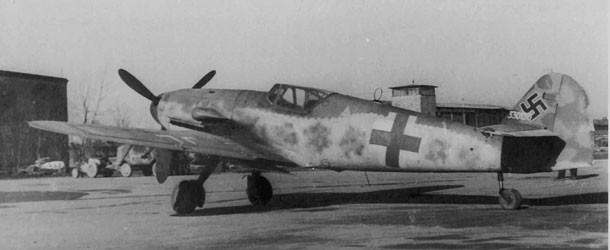
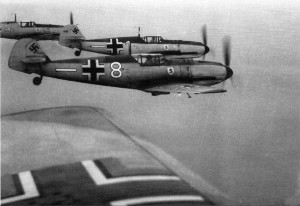
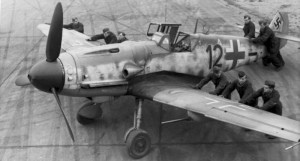
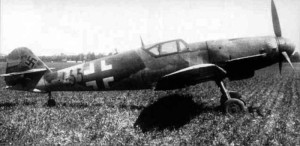
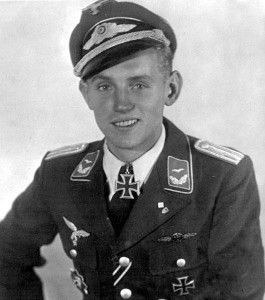
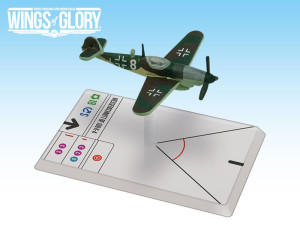
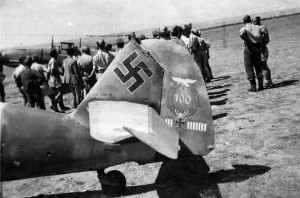








Follow Us on